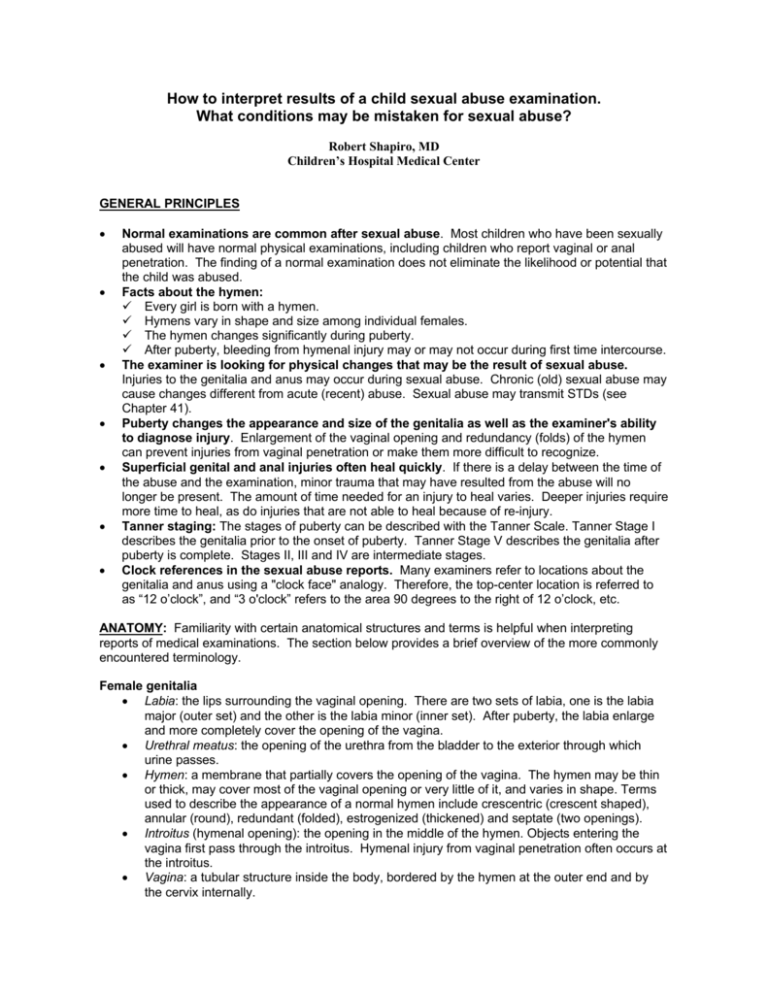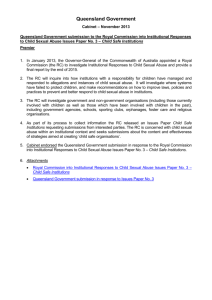
How to interpret results of a child sexual abuse examination.
What conditions may be mistaken for sexual abuse?
Robert Shapiro, MD
Children’s Hospital Medical Center
GENERAL PRINCIPLES
•
•
•
•
•
•
•
Normal examinations are common after sexual abuse. Most children who have been sexually
abused will have normal physical examinations, including children who report vaginal or anal
penetration. The finding of a normal examination does not eliminate the likelihood or potential that
the child was abused.
Facts about the hymen:
ü Every girl is born with a hymen.
ü Hymens vary in shape and size among individual females.
ü The hymen changes significantly during puberty.
ü After puberty, bleeding from hymenal injury may or may not occur during first time intercourse.
The examiner is looking for physical changes that may be the result of sexual abuse.
Injuries to the genitalia and anus may occur during sexual abuse. Chronic (old) sexual abuse may
cause changes different from acute (recent) abuse. Sexual abuse may transmit STDs (see
Chapter 41).
Puberty changes the appearance and size of the genitalia as well as the examiner's ability
to diagnose injury. Enlargement of the vaginal opening and redundancy (folds) of the hymen
can prevent injuries from vaginal penetration or make them more difficult to recognize.
Superficial genital and anal injuries often heal quickly. If there is a delay between the time of
the abuse and the examination, minor trauma that may have resulted from the abuse will no
longer be present. The amount of time needed for an injury to heal varies. Deeper injuries require
more time to heal, as do injuries that are not able to heal because of re-injury.
Tanner staging: The stages of puberty can be described with the Tanner Scale. Tanner Stage I
describes the genitalia prior to the onset of puberty. Tanner Stage V describes the genitalia after
puberty is complete. Stages II, III and IV are intermediate stages.
Clock references in the sexual abuse reports. Many examiners refer to locations about the
genitalia and anus using a "clock face" analogy. Therefore, the top-center location is referred to
as “12 o’clock”, and “3 o'clock” refers to the area 90 degrees to the right of 12 o’clock, etc.
ANATOMY: Familiarity with certain anatomical structures and terms is helpful when interpreting
reports of medical examinations. The section below provides a brief overview of the more commonly
encountered terminology.
Female genitalia
• Labia: the lips surrounding the vaginal opening. There are two sets of labia, one is the labia
major (outer set) and the other is the labia minor (inner set). After puberty, the labia enlarge
and more completely cover the opening of the vagina.
• Urethral meatus: the opening of the urethra from the bladder to the exterior through which
urine passes.
• Hymen: a membrane that partially covers the opening of the vagina. The hymen may be thin
or thick, may cover most of the vaginal opening or very little of it, and varies in shape. Terms
used to describe the appearance of a normal hymen include crescentric (crescent shaped),
annular (round), redundant (folded), estrogenized (thickened) and septate (two openings).
• Introitus (hymenal opening): the opening in the middle of the hymen. Objects entering the
vagina first pass through the introitus. Hymenal injury from vaginal penetration often occurs at
the introitus.
• Vagina: a tubular structure inside the body, bordered by the hymen at the outer end and by
the cervix internally.
•
Posterior fourchette: the area of mucosal skin where the labia minora meet (opposite end to
the clitoris).
• Fossa navicularis: the area of mucosal skin between the posterior fourchette and the hymen.
Male genitalia
• Glans: the tip of the penis surrounding the urethral opening
• Prepuce (foreskin): tissue that covers the glans in uncircumcised males. The prepuce is
removed during circumcision.
• Phimosis: adhesion of the prepuce to the glans.
The anus
• Anus: the opening of the rectum between the buttocks
• Sphincter: the muscles that surround the anus
• Anal verge: the area between the external and internal anal skins
• Rugae: folds of skin which radiate outward from the anus
INTERPRETATION OF NORMAL AND NON-SPECIFIC EXAMINATIONS: Most children who have
been sexually abused will have normal or non-specific physical examinations. Some of these normal
and non-specific findings are described below. These findings on their own are clearly not proof of
sexual abuse, but may be present in children who have been abused.
Normal or non-specific pre-pubertal female genital findings
• Bumps/tags/mounds: small protrusions on the hymenal edge
• Clefts: interruptions of the normally smooth hymenal edge. They are most commonly found
along the mid-horizontal plane of the hymen, at the 3 o’clock and 9 o’clock positions. When
present below this horizontal line, they may indicate healed injury.
• Redness/vaginitis/discharge: can be due to poor hygiene, infection, bubble bath, and other
causes.
• Intra-vaginal ridges/columns: normal folds of the vaginal wall
• Peri-urethral bands: support-like bands of tissue radiating from the urethral meatus
• Increased vascularity of vestibule or hymen: more than the usual number of blood vessels
within these tissues
• Posterior fourchette friability: the tendency of the posterior fourchette mucosa to bleed easily.
This finding seems to occur more often in children who have been abused but can also be
seen in non-abused children.
• Labial adhesions: joining of the labia minora. In some children, chronic labial irritation from
sexual abuse may be the cause of the adhesions, but this finding is very non-specific.
• Large hymenal opening. A large introital opening is suggestive of vaginal penetration, but one
cannot conclude that vaginal penetration has occurred unless specific signs of hymenal
trauma are also present. No conclusion regarding sexual abuse should be made based upon
the size of the vaginal opening alone.
Normal or non-specific pubertal female genital findings
• Redundant, fimbriated hymen: During puberty, the hymenal tissue becomes thicker and
redundant (folded), the opening into the vagina becomes larger, and the hymenal tissue
becomes more elastic and less sensitive to touch. The mucous covering the vaginal walls
becomes less prone to injury from abrasion. Folds in the hymen make examination difficult
and distinguishing folds from injury can be challenging
• Vaginal discharge: although discharge can be normal, it may also indicate infection
Normal or non-specific anal findings
• Fissures, excoriation, redness: may be seen after sexual abuse but there are other causes
• Anal tags: protrusion of tissue at the 6 o'clock or 12 o'clock midline positions
• Diastasis ani: smooth anal skin at the 6 o'clock or 12 o'clock midline positions
• Increased skin pigmentation and thickened anal skin folds
• Venous congestion: pooling of blood in the veins around the anus
• Gaping (wide open) anus: only normal if stool is present in the distal (end) anus
Interpret results of a child sexual abuse examination and conditions may be mistaken for sexual abuse.
Robert Shapiro
INTERPRETATION OF ABNORMAL EXAMINATIONS THAT REVEAL TRAUMA: Trauma may or
may not indicate sexual abuse. Some types of trauma are non-specific while others indicate that
sexual abuse has most likely occurred.
Pre-pubertal female genital trauma
•
•
•
Acute injuries to the genitalia cause bruising, lacerations (tears), abrasions (scrapes) and swelling.
Most of these injuries heal quickly without leaving any lasting signs to be found on later
examination. Acute genital injuries are always suspicious for sexual abuse, particularly when the
trauma includes the hymen. Accidental trauma usually involves the labia and/or the mons pubis.
Findings that indicate healed vaginal penetration
(Note: the legal definition of “penetration” may include contact with the external genital structures,
such as the labia, posterior fourchette and fossa navicularis. “Vaginal penetration” in this Chapter
refers to internal, vaginal penetration.)
ü Absent or significant defect of the posterior hymen (should be confirmed by examining the
child in knee-chest position)
ü Hymenal laceration or scar
Findings that may indicate vaginal penetration
ü Enlarged hymenal opening: “enlarged” can be difficult to define
ü Decreased amount of hymenal tissue
ü Irregularities, notches, and clefts of the posterior hymen
Female pubertal genital trauma
Signs of vaginal penetration can be more difficult to recognize, or may be absent, in the
adolescent. New hymenal tears and signs of acute injury are indications of recent vaginal
penetration. Transections (complete interruptions/breaks) in the hymen are present in some
virginal adolescents, but are more commonly seen in sexually active and sexually abused girls.
Consensual sexual activity does not typically cause genital bruising, abrasions or swelling.
Male genital trauma
Findings that indicate recent injury: swelling, abrasions, bruises, lacerations, bites. Acute injury is
always suspicious for sexual abuse.
Anal trauma
• Findings of acute anal injury include bruising, lacerations, abrasions and swelling. Most of these
injuries heal without leaving any lasting signs. Acute injury is always suspicious for sexual abuse.
• Scars may result from deep lacerations after sexual abuse and will be visible long after the abuse
occurred. Skin tags away from the midline of the anus may indicate healed injuries.
• Chronic sexual abuse may result in funneling (loss of subcutaneous fat around the anus), changes
in the anal skin, and decreased sphincter muscle tone. Decreased tone is defined as > 15 mm of
anal dilation with no stool in the distal anus.
Trauma outside the genital and anal areas
Injuries to a child's breasts, throat, mouth, or other areas, may occur following sexual abuse.
Specific injuries from oral gags or binding of the extremities may be found.
COMMON QUESTIONS WITH ANSWERS
• What types of sexual abuse are consistent with normal examinations?
Oral contact, digital fondling, genital rubbing, vaginal penetration after puberty, rectal penetration,
partial or attempted vaginal penetration, and penetration that has had time to heal.
• The child describes penetration but the exam is normal. How can this occur?
1. The pre-pubertal child who describes vaginal penetration may have experienced the pain of
partial or attempted penetration, but may not have been penetrated past the hymen. Although
the child describes penetration, since she could not “see” the extent of penetration, and has
no experience to be able to differentiate between full vaginal penetration and attempted or
partial penetration, her impression may be that she was penetrated. If pressure is exerted
against the hymen, most girls will experience pain. Keep in mind that, in many states, the
legal definition of penetration does not require vaginal penetration.
Interpret results of a child sexual abuse examination and conditions may be mistaken for sexual abuse.
Robert Shapiro
•
•
•
2. The pubertal adolescent may show no physical indications of vaginal penetration after sexual
intercourse. In many adolescents, the hymenal opening is large enough, and has sufficient
elasticity, to accommodate an erect male penis without tearing.
3. Rectal penetration often results in no signs of injury. The rectum of many children can
accommodate an erect male penis without injury, particularly if lubricated.
4. In general, trauma after penetration is more likely if the victim was young, physical force was
used, the penetration was deep, the victim was uncooperative, and/or the perpetrator used no
lubrication. Penetration with larger objects is more likely to result in injury than penetration
with smaller objects. Repeated penetration is more likely to result in injury than single
penetration.
Can the number of abuse episodes be determined by exam?
Not usually. If evidence of chronic anal abuse is present, multiple episodes of abuse occurred.
Vaginal injuries do not reliably differentiate between single episodes of abuse and multiple
episodes.
When did the injury occur?
If the injuries are acute (redness, swelling, tenderness, fresh abrasions or tears), the examiner
may reliably identify the injury as relatively recent, most likely having occurred within a few days of
the examination. Dating injuries within hours or to specific days is usually not possible.
Why does one examiner's report differ from another's?
Examination findings may differ when:
§ acute injuries heal between examinations
§ one of the examinations was not optimal because the child was uncooperative
§ the skill levels of the examiners differ. Examiners with expert training will provide a more
accurate and informative examination.
CONDITIONS THAT MIMIC SEXUAL ABUSE
• Non-specific vaginitis: many causes, including poor hygiene, bubble bath, antibiotics, nylon
underwear, and bed wetting.
• Vaginitis: many causes, including pinworms, streptococcal infection, and fungus infection.
• Vaginal foreign bodies: may cause bloody, foul smelling discharge. This is often caused by
residual toilet paper in the vagina.
• Peri-anal strep infection: presents with anal bleeding and redness
• Lichen sclerosus: hourglass shaped area of hypo-pigmented skin surrounding the anus and
genitalia, often with blood blister and other skin changes. Bleeding is common.
• Straddle injuries (accidental trauma): abrasions, bruising, swelling of the labia. Occasionally may
involve the introitus.
• Urethral prolapse: the urethra protrudes past the urethral opening and presents with a bloody, or
blood-tinged, swollen lesion around the top of the introitus. Often, the urethral origin of this mass
cannot be easily recognized and it may be mistaken for trauma.
References:
Hymel, Kent P, Jenny, Carole. Child Sexual Abuse. Pediatrics in Review Vol. 17: no 7; p 236 - 249.
1996
Botash, Ann S. Examination for Sexual Abuse in Prepubertal Children: An Update. Pediatric Annals
26:5 May 1997 pp312-320/
Interpret results of a child sexual abuse examination and conditions may be mistaken for sexual abuse.
Robert Shapiro









